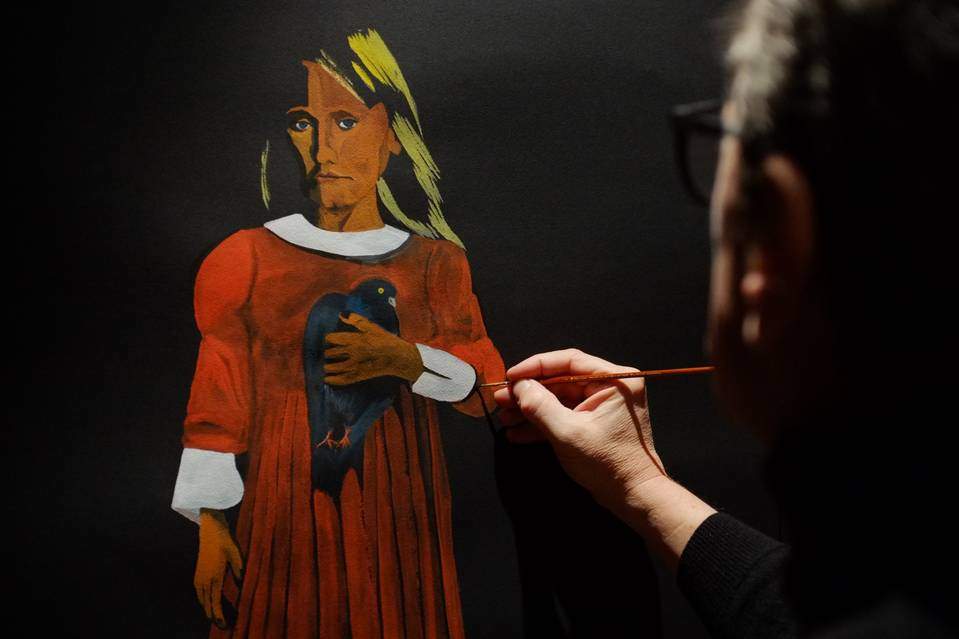
The former telecoms titan tells Victoria Coleman-Smith how a personal crisis ignited a lifelong passion
For many people a lucrative and successful career as a high-flying serial entrepreneur and telecoms executive would be the summit of their ambitions. But Philipp Rudolf Humm, 59, always felt he was acting a part.
‘I had tried to get into art school as a teenager, in Berlin, that was my true passion,’ he says. ‘I worked for a photographer, did a philosophy degree, moved into advertising and then into marketing and business. My career has been very diverse. I have always understood that as a manager, you are playing a temporary role. If you are an artist you’re a creator; you make something that has a legacy to it.’
So when a personal crisis forced changes in his life a couple of years ago, Humm leapt at the possibility of reinvention. ‘I separated from my wife, who is the mother of my three adult children, and that was a point of reflection. I left T Mobile in Seattle and came to London in 2012 to be CEO of Vodafone and then started taking drawing and painting classes again.’
It was clear that if art was ever going to be more than a hobby he needed to devote more time to it so in summer 2015 Humm decided to take the plunge and become a full-time artist, leaving ‘quite a few big CEO jobs on the table’. He signed up at the London Fine Art school, painting from life mornings and afternoons four days a week. It was a time of rapid creative development. ‘I wanted to achieve a level of skill where I could get somebody’s likeness both in oil and charcoal, and have no limitations,’ he recalls. ‘I immersed myself in art. I became a Tate patron took classes in Florence and visited museums and art galIeries, in London, Paris, Brussels, and Munich.’
Humm has German and Belgian parents and his art and life have an eclectic and international flavour. He went to a French school in Germany, did an MBA and has worked for Procter and Gamble in Saudi Arabia, for Amazon and then in telecoms. He cites the German existentialist Mačke and the Belgian surrealist Delvaux as influences on what eminent art critic Edward Lucie-Smith has called his ‘pop expressionistic style’: ‘The Macke were very strong on colours, emotions, landscapes and animals. Delvaux painted Greek statue-like nudes in a very surrealist environment. My own style evolved out of these two approaches.’
Humm describes himself as a narrative, figurative artist. ‘The beauty of that is you have a story,’ he says. ‘It’s a bit like theatre.’ His ideas germinate from an organic process of viewing and reflection: ‘I walk round museums and only stop at paintings I find interesting. They sit in my brain and then gradually associations begin to happen. Then I have an idea and sketch it out. When I’m happy with it I draw five big drawings directly onto the canvas.’
He uses a variety of media, mainly gouache and oils and paints in series exploring a larger overarching theme through several paintings. His first London exhibition, at Riflemaker gallery last November, was called ‘Being and Time’. The six works in the series put iconic images from art and history into modern environments. The resulting tension is heightened by the pop-like colour and the rich Italianate lustre of the oils.
In one work, Adulation, Manet’s Olympia is transposed into a modern setting where a curious paparazzi-style crowd peer at her from behind a curtain. Humm’s approach is rooted in European cultural traditions. ‘I studied Heidegger’s Being and Time as part of my philosophy degree. For this series, I was reflecting on what makes a human a human versus the difference between the subject and the object. If you look at my paintings, people are always a bit in between being a subject and an object; an authentic personality or a cliché. It began with Renaissance subjects but has now become more modern in focus.’
Humm’s first major show of collected works to date, Urban Portraits, runs from the end of January to March at the CNB gallery, east London. It comprises all of his three major series’ to date, Being and Time, Plastic, and Moments. Plastic was his first series and its autobiographical themes reflect his early experiences as an artist. Painted in gouache on paper, the works are a surreal contemplation of the eclectic and materialist world he encountered when he first moved to London and show tragi-comic aged male figures and mannequin women acting out parables of twenty-first century excess.
With his continuing series of portraits, Moments, Humm focuses on the face and hands; and isolates them against a background of unblended planar colours in oil on canvas. The works ‘freeze a moment’ with the subjects asked to gesture and express themselves in ways that are typical for them. The bold colour palette and flattened perspective are reminiscent of portraits by David Hockney.
In Humm’s view, the pendulum is swinging back towards narrative and figurative painting, and perhaps, he hopes, towards ‘pop expressionism’. ‘The art world is now moving away from the pure abstraction of the last decades,’ he says. ‘If you look at the curricula in German and US universities they really emphasise learning the skills. That shift benefits me personally and I see quite a few artists moving in a similar direction. There isn’t a movement yet, but it might happen over the next few years as people get to know each other.’ He intends to keep developing his own skills and sharing ideas. ‘What I want to do in future is to work with artists I really like and learn from them – wherever in the world there are interesting people.’
Philip Rudolf Humm, Urban Portraits, CNB Gallery, 31st January-4th March 2017






